Related Research Articles

Lobsang Trinley Lhündrub Chökyi Gyaltsen was the tenth Panchen Lama, officially the 10th Panchen Erdeni, of the Gelug school of Tibetan Buddhism. According to Tibetan Buddhism, Panchen Lamas are living emanations of the buddha Amitabha. He was often referred to simply as Choekyi Gyaltsen.
Miss Tibet is an annual beauty pageant held in McLeod Ganj, India. It is produced by Lobsang Wangyal Productions.

The Seventeen-Point Agreement, officially the Agreement of the Central People's Government and the Local Government of Tibet on Measures for the Peaceful Liberation of Tibet, was an agreement between the Tibetan Government and the People's Republic of China. It was signed by plenipotentiaries of the Central People's Government and the Tibetan Government on 23 May 1951, in Zhongnanhai, Beijing. The 14th Dalai Lama ratified the agreement in the form of a telegraph on 24 October 1951. The Agreement was legally reputiated by Tibet less than eight years later on 11 March 1959.
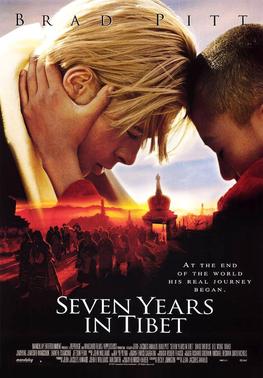
Seven Years in Tibet is a 1997 American biographical war drama film directed by Jean-Jacques Annaud. It is based on Austrian mountaineer and Schutzstaffel (SS) sergeant Heinrich Harrer's 1952 memoir of the same name, about his experiences in Tibet between 1944 and 1951. Seven Years in Tibet stars Brad Pitt and David Thewlis, and has music composed by John Williams with a feature performance by cellist Yo-Yo Ma.

Ngapoi Ngawang Jigme was a Tibetan senior official who assumed various military and political responsibilities both before and after 1951 in Tibet. He is often known simply as Ngapo in English sources.

The national anthem of Tibet, commonly referred to as "Gyallu", is a Tibetan patriotic song which serves as the de facto anthem of the Central Tibetan Administration.

The 1959 Tibetan uprising began on 10 March 1959, when a revolt erupted in Lhasa, the capital of Tibet, which had been under the effective control of the People's Republic of China (PRC) since the Seventeen Point Agreement was reached in 1951. The initial uprising occurred amid general Chinese-Tibetan tensions and a context of confusion, because Tibetan protesters feared that the Chinese government might arrest the 14th Dalai Lama. The protests were also fueled by anti-Chinese sentiment and separatism. At first, the uprising mostly consisted of peaceful protests, but clashes quickly erupted and the Chinese People's Liberation Army (PLA) eventually used force to quell the protests. Some of the protesters had captured arms. The last stages of the uprising included heavy fighting, with high civilian and military losses. The 14th Dalai Lama escaped from Lhasa, while the city was fully retaken by Chinese security forces on 23 March 1959. Thousands of Tibetans were killed during the 1959 uprising, but the exact number of deaths is disputed.
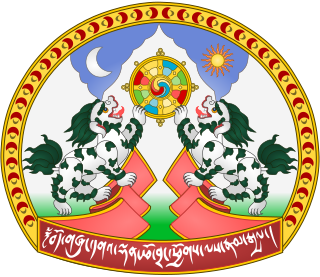
The Tibetan Parliament in Exile (TPiE), officially the Parliament of the Central Tibetan Administration, is the unicameral and highest legislative organ of the Central Tibetan Administration, the government-in-exile of the Tibet Autonomous Region of China. It was established and is based in Dharamshala, India. The creation of this democratically elected body has been one of the major changes that the 14th Dalai Lama brought about in his efforts to introduce a democratic system of administration.

The Kashag was the governing council of Tibet during the rule of the Qing dynasty and post-Qing period until the 1950s. It was created in 1721, and set by Qianlong Emperor in 1751 for the Ganden Phodrang in the 13-Article Ordinance for the More Effective Governing of Tibet. In that year the Tibetan government was reorganized after the riots in Lhasa of the previous year. The civil administration was represented by the Council (Kashag) after the post of Desi was abolished by the Qing imperial court. The Qing imperial court wanted the 7th Dalai Lama to hold both religious and administrative rule, while strengthening the position of the High Commissioners.

Lodi Gyaltsen Gyari Rinpoche, Kasur Lodi Gyari or "as he is universally known to the Tibetan-speaking world, Gyari Rinpoche" was a Tibetan politician, and journalist who served as the 14th Dalai Lama's special envoy to the United States. Exiled to India in 1959, he was also the executive chairman of the International Campaign for Tibet.
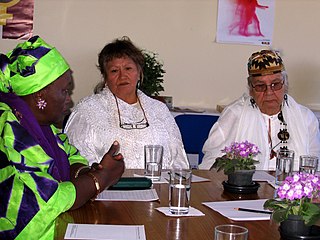
The International Council of Thirteen Indigenous Grandmothers is an international alliance of indigenous female elders that focuses on issues such as the environment, internationalism, and human rights. The group met for the first time in October 2004 at the Dalai Lama's Menla Retreat Center on Panther Mountain in Phoenicia, New York, during which time they declared themselves a council. Academic Suzanne Bouclin described them as "an alliance of thirteen women elders from across the globe that was organized to uphold indigenous practices and ceremonies and affirm the right to use plant medicines free of legal restriction."
Beatrice Long Visitor Holy Dance was an Oglala Lakota speaker and activist from the Pine Ridge Reservation in South Dakota, best known for her participation in the group known as the International Council of 13 Indigenous Grandmothers, which was founded in New York in 2004. In 2008, The 13 Indigenous Grandmothers, including Beatrice, hand delivered a petition to Pope Benedict XVI asking to revoke the three papal bulls authorizing the conversion and subjugation of the Indigenous Peoples of America. This letter went unanswered.
Rita Long Visitor Holy Dance is a Native American spiritual elder who is a member of the Oglala Lakota Tribe and comes from the Pine Ridge Reservation in South Dakota. Through her work as an indigenous elder stateswoman, Rita has gained international recognition through her work as part of the International Council of 13 Indigenous Grandmothers - a group of spiritual elders, medicine women and wisdom keepers since its founding in 2004.

Human rights in Tibet are a contentious issue. Reported abuses of human rights in Tibet include restricted freedom of religion, belief, and association; arbitrary arrest; maltreatment in custody, including torture; and forced abortion and sterilization. The status of religion, mainly as it relates to figures who are both religious and political, such as the exile of the 14th Dalai Lama, is a regular object of criticism. Additionally, freedom of the press in China is absent, with Tibet's media tightly controlled by the Chinese leadership, making it difficult to accurately determine the scope of human rights abuses.

The Battle of Chamdo occurred from 6 to 24 October 1950. It was a military campaign by the People's Republic of China (PRC) to take the Chamdo Region from a de facto independent Tibetan state. The campaign resulted in the capture of Chamdo and the annexation of Tibet by the People's Republic of China.
Gyatsho Tshering, also spelled Gyatso Tsering, was Tibetan scholar of Indian nationality. He was the former director of the Library of Tibetan Works and Archives.
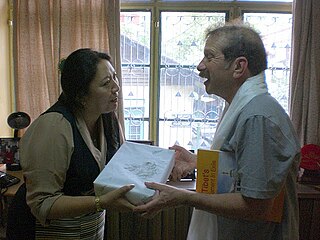
Dölma Gyari is a well-known Tibetan politician in exile, a former activist, active since the early 1980s.

Lobsang Dolma Khangkar also called Lobsang Dolma or Ama Lobsang Dolma was a 13th generation doctor of traditional Tibetan medicine. She travelled with the Dalai Lama in 1959 from Tibet to India. She was the First woman to become chief physician of the Men-Tsee-Khang. She and the others carried her daughters on their backs into what is now Dharamsala, India: Tsewang Dolkar Khangkar and Pasang Gyalmo Khangkar, succeeded her in the family line of doctors, the Khangkar.
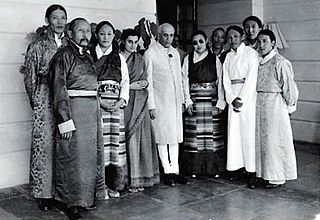
Tsering Dolma was the founder of the non-profit refugee organisation Tibetan Children's Villages and was the older sister of the 14th Dalai Lama, Tenzing Gyatso.

Thubten Samphel was a Tibetan writer, journalist, and government official. He worked as a secretary in the Ministry of Foreign Affairs and was a spokesperson of the Central Tibetan Administration, based in Dharamshala. He also worked for the administration's think tank, Tibet Policy Institute.
References
- Grandmothers' Council website about the Grandmothers
- Native Village Publications, Grandmother Tsering Dolma Gyaltong [usurped]
- Sacred Studies, Grandmother's Biographies
- Schaefer, C, (2006) Grandmothers Council the World: wise women elders offer their vision for our planet. Trumpeter Books 978-1-59030-293-4
- Supriano, S, Steppin’ Out of Babylon. (2009-04-06) Interview with Agnes Baker Pilgrim - Chairperson of the International Council of 13 Indigenous Grandmothers and the oldest living member of the Takilma Siletz nation of Southern Oregon
- Tibetan Women's Association, Creation.
- Tibetan Women's Association, (2006-10-13), Fourth International Council of Thirteen Indigenous Grandmothers
- Tibetan Women's Association, Former Executives
- Tibetan Women's Association, Dolma (Publication), English Version, 2009
- Tibet Women's Delegation (1996) Dialogue Between Nations